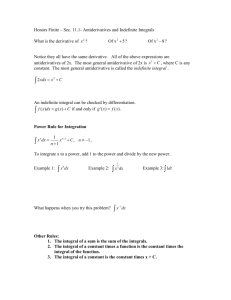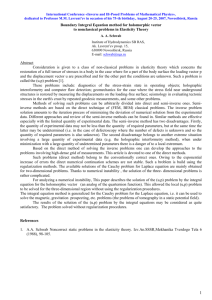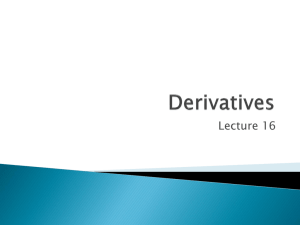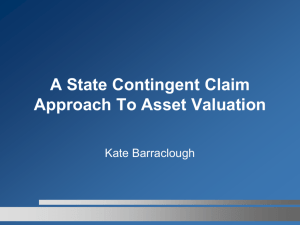For the reverse case of stock short and options (or warrants) long
advertisement
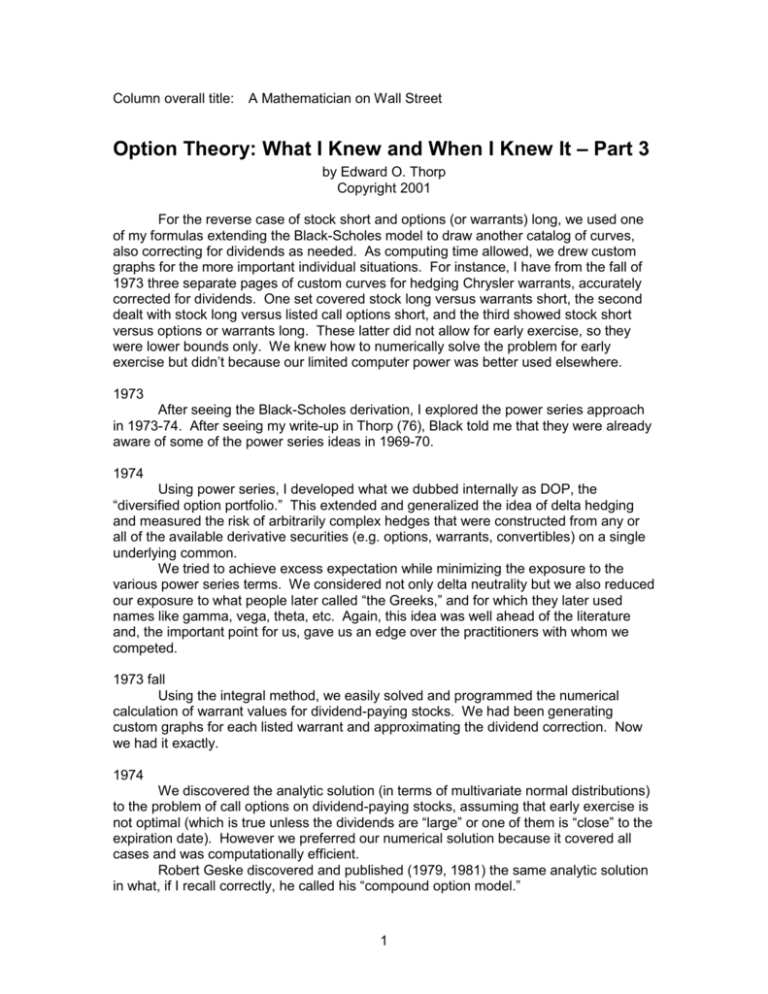
Column overall title: A Mathematician on Wall Street Option Theory: What I Knew and When I Knew It – Part 3 by Edward O. Thorp Copyright 2001 For the reverse case of stock short and options (or warrants) long, we used one of my formulas extending the Black-Scholes model to draw another catalog of curves, also correcting for dividends as needed. As computing time allowed, we drew custom graphs for the more important individual situations. For instance, I have from the fall of 1973 three separate pages of custom curves for hedging Chrysler warrants, accurately corrected for dividends. One set covered stock long versus warrants short, the second dealt with stock long versus listed call options short, and the third showed stock short versus options or warrants long. These latter did not allow for early exercise, so they were lower bounds only. We knew how to numerically solve the problem for early exercise but didn’t because our limited computer power was better used elsewhere. 1973 After seeing the Black-Scholes derivation, I explored the power series approach in 1973-74. After seeing my write-up in Thorp (76), Black told me that they were already aware of some of the power series ideas in 1969-70. 1974 Using power series, I developed what we dubbed internally as DOP, the “diversified option portfolio.” This extended and generalized the idea of delta hedging and measured the risk of arbitrarily complex hedges that were constructed from any or all of the available derivative securities (e.g. options, warrants, convertibles) on a single underlying common. We tried to achieve excess expectation while minimizing the exposure to the various power series terms. We considered not only delta neutrality but we also reduced our exposure to what people later called “the Greeks,” and for which they later used names like gamma, vega, theta, etc. Again, this idea was well ahead of the literature and, the important point for us, gave us an edge over the practitioners with whom we competed. 1973 fall Using the integral method, we easily solved and programmed the numerical calculation of warrant values for dividend-paying stocks. We had been generating custom graphs for each listed warrant and approximating the dividend correction. Now we had it exactly. 1974 We discovered the analytic solution (in terms of multivariate normal distributions) to the problem of call options on dividend-paying stocks, assuming that early exercise is not optimal (which is true unless the dividends are “large” or one of them is “close” to the expiration date). However we preferred our numerical solution because it covered all cases and was computationally efficient. Robert Geske discovered and published (1979, 1981) the same analytic solution in what, if I recall correctly, he called his “compound option model.” 1 1974 fall We were told that the CBOE would start trading American puts “soon.” After the Black-Scholes formula, this was the central unsolved problem in option theory. Because of the ease and power of the integral model, I was able in an hour to conceive and outline the solution to the problem for my programmer. It used recursive numerical integration of the log normal probability density function for the stock, using the appropriate riskless rate for the expected growth rate and for the discount to present value, as described earlier. All the boundary conditions were incorporated and the time and space steps used for the backward integration were chosen fine enough to give the desired accuracy. This solution was complete: it incorporated dividends and determined the early exercise region. We drew graphs and printed tables. At a one-on-one dinner meeting to which Fisher Black invited me on May 14th or 15th, 1975, just prior to the University of Chicago Center for Research in Securities Prices (CRSP) meeting in Chicago, I brought along my solution to the American put problem and had placed a folder of graphs on the table to show him. Then he said no one had solved the problem, and asked what I thought about the “numerical solution to p.d.e.” approach. While I was giving my view that the approach worked but one had to be careful in choosing the sizes and relative sizes of the time and space steps (I had already looked at it and seen how to do it, but chose instead to use the integral method as “easier.”) I realized I had a fiduciary duty to my investors to keep our secrets, and quietly put my folder with the world’s first American put curves back in my briefcase. Schwartz and Parkinson each published solutions in 1977 that were “cousins” to our integral method version. 1974 In my classes at U.C. Irvine, I taught that there were three roads to option theory: [1] [2] [3] The integral model, “all powerful” for producing numerical (and some analytical) solutions. Stochastic differential equations (Black-Scholes 1973, Merton 1992), the most elegant and technically demanding approach. Useful for producing analytic formulas when they existed but they did not always lend themselves as easily to solving problems numerically. Power series: very useful for special problems. I didn’t “teach” a fourth method, the Monte Carlo approach, since it seemed obvious and, though appropriate for solving various options problems, had much wider applicability. Later, Bill Sharpe’s suggestion led the finance world to the development of a fifth method, the binary model. This is closely related to the integral model, just as discrete binary random walks in the limit tend to Brownian motion. 1975-1985 We were able to stay ahead using the integral model, then later converting to the binary model for greater computational speed, but as the financial literature advanced much of our theoretical edge in option theory slowly vanished. The Black-Scholes methodology revolutionized finance, “everyone” adopted it, and listed option spreads narrowed until only the competitors with the lowest costs could still extract excess risk adjusted returns. However in practice we were able to stay ahead in derivatives trading 2 through our computer programs and applications, especially in convertible bonds and in the analysis of an expanding crop of new derivative products. There is a lot more to this account. I have cartons of rough notes, and research ideas which I explored, both in derivative theory and practice and in other areas of finance. Keeping what we discovered secret, while benefiting from ongoing published academic work, was a major factor in producing some $250 million in profits for CHA/PNP. 2000 Convertibles and other derivative hedging is still profitable. The derivatives based market inefficiencies exploited in Beat the Market have expanded vastly in number and size and account for a significant part of today’s hedge fund industry. A salient example is the $8 billion Chicago based Citadel Investments with its domestic and offshore partnerships. Under its principal general partner, Kenneth Griffin, now in his early thirties, it recently celebrated its tenth anniversary with a 30% annual compound rate of return for the decade. It’s widely considered to be the most valuable hedge fund business in the world. Another concept, first discovered at Princeton-Newport in December 1979 or January 1980, is the core idea of what is now called statistical arbitrage. The more primitive “pairs trading” had already been discovered at PNP and used in minor ways in the late 70s. Based on the approximately Brownian motion structure of stock prices, the idea has led to a set of techniques for “draining energy” (i.e. money) from the ceaselessly excessive (see Schiller) fluctuations in stock prices. Note on the integral model: The key is the observation that growth and discount rates can all be set to r , the riskless rate. Cox-Ross later proved in 1976 that this is correct (see Merton, 1992, pp 334ff). As soon as I saw the Black-Scholes proof in 1973, I felt certain that this consequence of their result applied not only to call options but generally to all derivative problems using log normal diffusion for the underlying security. I then immediately implemented this in numerically solving by iterated numerical integration, backward from the terminal value, in “small” time steps. Fortunately for me, this method was ours alone to practice from 1973 to 1976, and even after the Cox-Ross proof, we didn’t know of other practitioners who adopted it. 3

